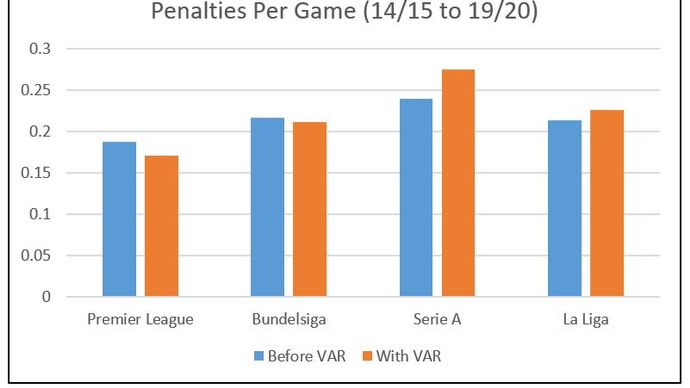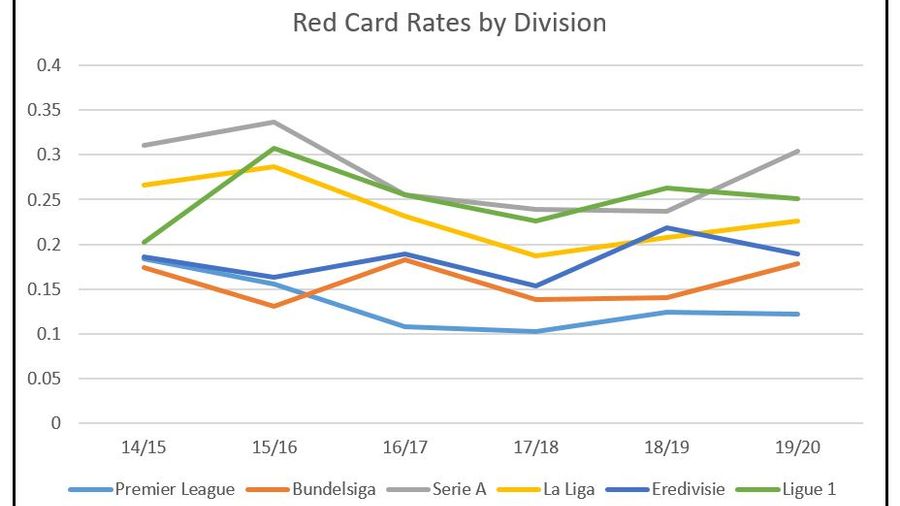Dave Pilgrim uses his statistical knowledge to find out if VAR really is having as big an impact on the major decisions in football as people think.
There can be little doubt that the biggest talking point of the 2019/20 Premier League Season has been the almost unanimously unpopular introduction of VAR. Despite waiting patiently to ensure we would garner the lessons learnt from pretty much every major league in the world, the supposed seamless integration into the oldest league in the world has been an unmitigated disaster thus far.
Rather than simply allowing technology to ensure we get every decision right, VAR has instead opened up a whole new debate as to what “right” actually means, and when it should be applied. Furthermore, the whole notion of “clear and obvious” has been universally interpreted as “if the referee thought that X [insert handball, foul, penalty] happened (which it didn’t), then it can’t have been clear and obvious, so we better not get involved”.
The big questions we have to ask as punters are none of the above however. As football fans we certainly care about enjoying the game as much as possible (however VAR evolves), but as punters we need to ask a subtly different question;
What has been the impact upon on-field events, and should I believe or question the general rhetoric?
🦊 Ben Chilwell gives Leicester the lead!
— Sporting Life Football (@SportingLifeFC) October 25, 2019
👀 AND we have VAR drama with Ryan Bertrand shown a straight red card for a tackle in the build-up!
📺 We've just witnessed VAR working well...#SaintsFC | #LCFC | #SOULEI pic.twitter.com/N6sHyKQAV5
The most commonly held belief on the eve of the new Premier League season was that we would see a noteworthy rise in the rate of Penalties and Red Cards being awarded. We had all watched the 2018 World Cup, where “Penalty in Match” was as short as 6/4 with bookmakers by the time the final came around. 29 penalties were awarded over the 64 matches, with over 13% of all goals scored coming from the spot in that tournament, so you can see why so many predicted a fest. How has the reality panned out domestically though? And what other evidence can we add in from other divisions with a bigger sample?
Now in terms of looking at the data I must note an important assumption I have made. Gathering data about Penalties Scored allows a much greater sample, over more leagues, than that easily available for Penalties Taken. For this reason, rather than approach this from an angle of Penalties Taken, I will assume that there has been no discernible chance in the rate of a penalty being scored per penalty taken and use the “Penalties Scored” as a relative proxy for those taken.
After Round 29 of the Premier League campaign, we have seen 287 Premier League games in the 2019/20 season, with 780 goals scored at a rate of 2.718 per match. Of those goals, 49 have been spot kicks – 6.3% of all goals scored, or 0.171 per game. Although rare, it is possible for more than one penalty to be scored in a match of course, so the true average odds of a penalty being scored in a Premier League match so far this season are somewhere in the order of 5/1 – certainly no shorter.
But how does this compare with previous seasons?

In the five season’s prior to the introduction of VAR, we saw 358 Penalties Scored – from a total of 1900 matches. Those matches produced 5155 goals (a rate of 2.71 goals per game). On the penalty front therefore, under VAR we have seen the proportion of goals coming from the penalty spot drop from 6.9% to 6.3% - insignificant given natural variance, while penalties scored per game has dropped from 0.188 to 0.171 – again, an insignificant move.
Penalties are now being spotted for handballs and fouls, but diving is now less likely to result in a penalty. These behaviours seem to have pretty much cancelled themselves out. In essence, from a betting perspective, targeting penalty takers is no more likely to lead you to a winner in the Premier League than was ever the case before. That bet on Luka Milivojevic being Palace’s top scorer this season will be a loser in all likelihood.
😡 Giovani Lo Celso stamps on Azpilicueta
— Sporting Life Football (@SportingLifeFC) February 22, 2020
👀 Michael Oliver misses incident
📺 VAR somehow say no red card
😳 Stockley Park admit mistake but won't take retrospective action
📽️ Thoughts?! #CFC #THFC pic.twitter.com/o63Vj6eJS5
Has the Premier League been unique, or has the same story already played out before?
Serie A - Introduced at the start of the 17/18 season, Italy was one of the early adopting countries.
Prior to VAR, we saw 14/15, 15/16 and 16/17 run at a rate of 0.24 penalties scored per game, contributing 8.8% of all goals. Since the introduction we have seen the subsequent two and a half seasons run at a rate of 0.275 penalties scored per game, and 10.1% of all goals. It should be noted we have seen a very sizable growth in 2019/20, although the samples are still modest so it could prove to be nothing more than noise.
La Liga – Introduced in 18/19, so now into their second season.
Historically Spain was seeing around 7.4% of all goals coming from the spot (2014/15 to 2017/18), and around 0.217 penalties scored per match prior to the introduction of VAR. Since then, almost exactly 600 VAR matches, we have seen 7.8% of goals coming from the spot, and 0.212 penalties per match. Basically, VAR hasn’t impacted anything in the betting context here.
Bundesliga – brought in at the same time as Italy adopted in the 17/18 season, we are now well into our third year of the technology.
Average goals are up since the introduction of VAR – from 2.8 to 3.05 which looks a noteworthy trend, although perhaps hard to explain why. Bundesliga has always been an entertaining division, but these days it’s off the scale for some reason. In terms of penalties, again, very little has changed – down slightly from 7.6% of goals to 7.4%, and up marginally from 0.214 per game to 0.226.
What about Red Cards?
📺 History made at Crystal Palace as Michael Oliver actually uses the VAR screen before sneding Milivojevic off!
— Sporting Life Football (@SportingLifeFC) January 5, 2020
🟥 The ref reviewed a potential headbutt before getting the red card out - a sign of things to come?#FACup #CRYDER pic.twitter.com/wF5mrpDo3A
The Premier League has seen 35 Red Cards this season – a rate of 0.12 per game (or a 7/1 shot if you like). Not discernibly different to the 0.134 rate witnessed in the previous five preceding seasons. Looking at other divisions it looks like we might have predicted that kind of impact.
In Germany for instance, while 2019/20 is marginally up, comparing Pre-VAR (0.162 per match) with VAR (0.149) shows a marginal drop. In Italy we’ve seen a similar pattern, with Pre-VAR rate (0.301) to Post-rate (0.254) dropping despite a slight pick-up in 2019/20, while La Liga has dropped from an average of 0.242 (14/15 to 16/17) to 0.215 (17/18 to 19/20).
Only in Holland and France have we seen an sort of increase when comparing pre-VAR with post-VAR, and neither have been particularly noteworthy. Eredivisie has increase from 0.173 to 0.206 per match, while in France we’ve seen a modest rise from 0.248 to 0.258.

Conclusion
It’s fair to say that the notion that penalties are more prevalent in the VAR era has proved to be nothing but an urban myth – with none of the four major leagues included in the shallow dive showing any significant increases in penalty rates whatsoever. The variance in Red Cads appears to be similarly unaffected – with four of the six biggest European leagues showing a slight drop, and two marginally up – all small enough to be put down to nothing more than seasonal fluctuations.
Hopefully it will all end up worth it – the close season break is almost certain to see procedures changed to increase the speed in which decisions are made, and how the responsibilities are assigned. Perhaps increased ownership will be allocated to the VAR room to intervene at their discretion. In the short term though, you shouldn’t have altered your approaches as a punter. Nothing has changed, except perhaps the odds you are offered on a penalty being awarded.









